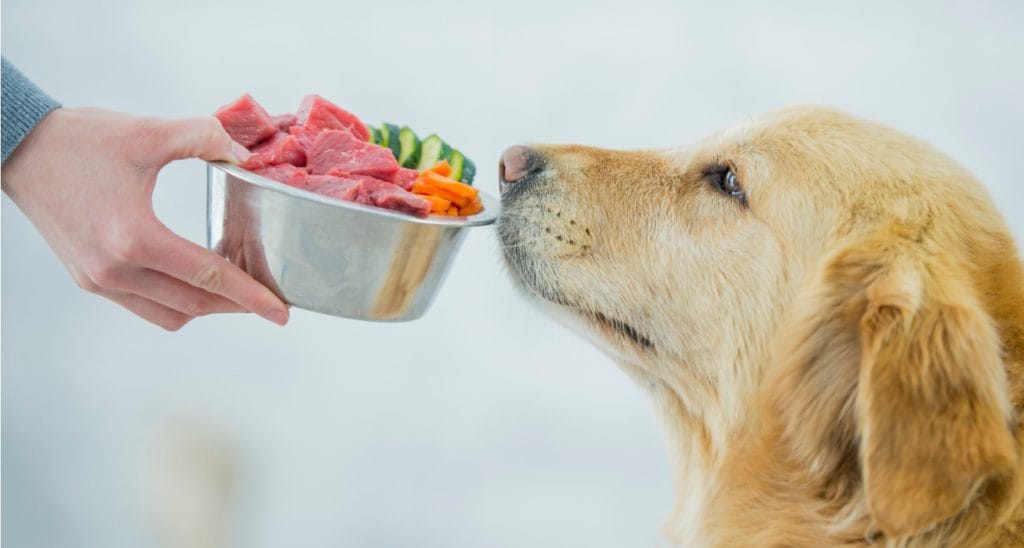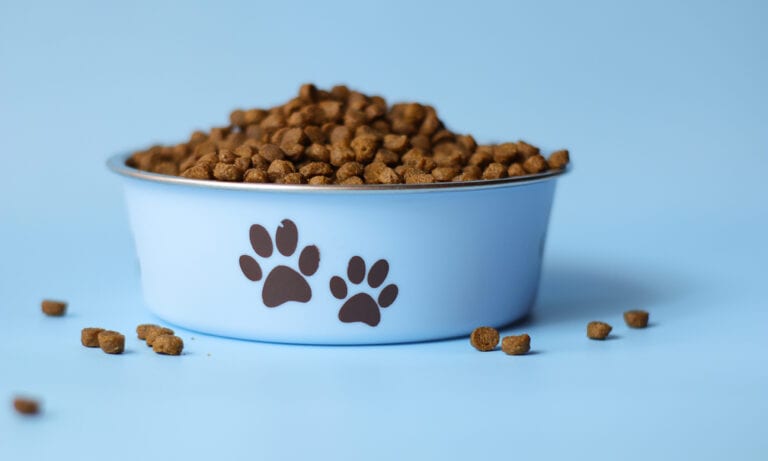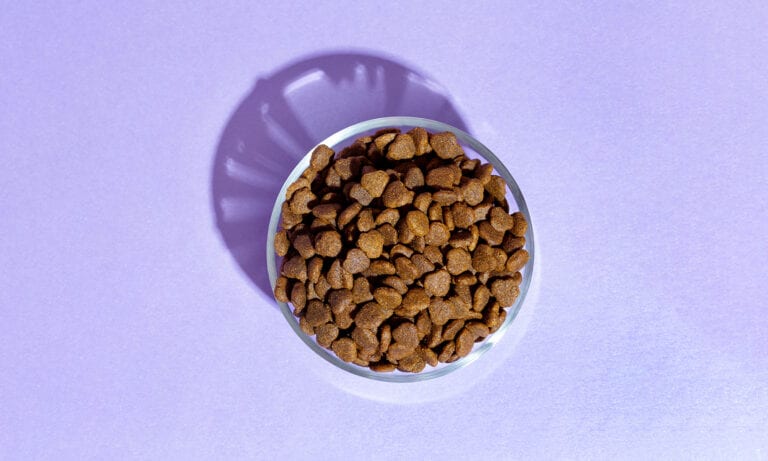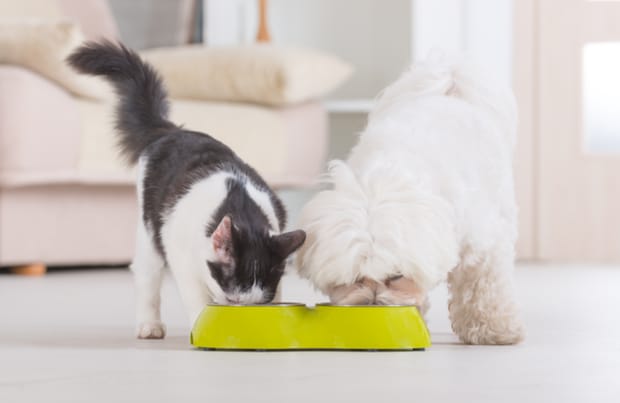Are you feeding your dog a raw or a homemade diet? If you’re just feeding her meat and grains, it’s surprisingly easy to skip important nutrients she needs to remain healthy.
“Many dogs on homemade diets are fed chicken and rice or hamburger and rice for years by their well-meaning owners,” says Dr. Judy Morgan, a certified veterinary food therapist, holistic veterinarian and author. While these dogs usually are okay health-wise (Morgan suspects it’s because many of them are also fed commercial dog treats that have vitamins and minerals added), a more nutritious, well-balanced meal will allow your dog to thrive instead of just survive.
It’s important to discuss your options with a veterinarian if you’re going to feed a homemade or raw dog food diet, and Morgan says you have to be careful in your search.
“Many veterinarians are not comfortable making homemade recipes for dogs, but there are many nutrition experts joining the field, so they have become easier to find,” she says.
If you’re already feeding raw or homemade food, or if you’re looking to start your dog on a homemade diet, here are eight things to add to the mix for increased nutritional benefits:
Pumpkin

iStock.com/EugeneTomeev
Pumpkin is a wonderful addition to a dog’s diet because it provides soluble and insoluble fiber, both of which are needed to keep the microflora (good bacteria) in the gut healthy, Morgan says. “Pumpkin can help cure a case of diarrhea or ease constipation. It also helps regulate bowel function.”
Pumpkin is best served cooked (or canned, which is already cooked). “If served raw it would need to be finely ground to have any benefit, as it is difficult to digest,” Morgan adds.
Carrots

iStock.com/ChesiireCat
While you might think carrots contain a lot of sugar, they are usually a fine addition to a dog’s diet when fed in small quantities. “They make great low-calorie snacks when fed raw (make sure your dog chews into small pieces),” says Morgan. “Gently cooked carrots will be digested more.”
They also provide beta carotene and antioxidants, which support eye health, according to Morgan.
Raw Fruits

iStock.com/onetouchspark
Raw fruits, like apple slices and cantaloupe pieces, are great additions to your dog’s diet, according to Dr. Jennifer Adolphe, RD, who holds a Ph.D. in companion animal nutrition from the University of Saskatchewan. “These foods are packed with nutrients such as vitamin C, beta-carotene and dietary fiber, but are low in calories so they won’t add inches to your dog’s waistline,” she says.
You can feed these as once-in-a-while snacks (instead of fatty treats) or cut them in tiny pieces or mash them and mix them with your dog’s meal.
Yogurt

iStock.com/Eva-Katalin
Plain yogurt is a source of live active cultures that may offer digestive health benefits for your dog, says Adolphe. “It is also a source of essential nutrients such as protein and calcium.”
Yogurt contains moderate levels of lactose, a naturally-occurring sugar in milk. “Some pets have difficulty digesting lactose, so introduce yogurt gradually to prevent digestive upset and discontinue use with any signs of intolerance,” Adolphe says.
Canned Fish

iStock.com/Piotr Wytrazek
Canned fish is a great source of source of omega-3 fatty acids, which are needed for heart, joint, brain, and skin health, Morgan says. For her own dogs, Morgan uses sardines in water to lower the calorie content.
“A whole can of sardines contains about 90 calories, but if you’re only adding one small fish from the can, you are not adding many calories,” she adds.
Mushrooms

iStock.com/jatrax
Mushrooms are not a typical option that comes to mind when thinking of a pet-friendly food, but Morgan says shiitake or reishi mushrooms are actually a great choice.
“They help regulate bowel function, but their main attraction is their ability to fight cancer and support the immune system,” says Morgan. “Shiitake, reishi, maitake, lion’s mane, king trumpet, turkey tail, and himematsutake mushrooms are all great.”
Morgan recommends serving them lightly cooked in a tiny amount of olive or coconut oil.
Oatmeal

iStock.com/creacart
Oatmeal cooked with water is an excellent source of beta-glucan, a special type of soluble fiber that may offer health benefits, including weight management and bowel regularity, Adolphe says.
As with all food for both you and your dog, Adolphe recommends following food safety guidelines for preparing, storing and serving: “Keep hot foods hot, and cold foods cold – bacteria thrive in the temperature danger zone between 39 and 140 degrees Fahrenheit. Remember, you cannot tell if a food is unsafe by its smell or taste.”
Peanut Butter

iStock.com/martinedoucet
Peanut butter is high in calories, but Adolphe says it can be used as an extra-special treat stuffed into your dog’s favorite toy to keep him occupied or to help him swallow his not-so-favorite medication. “Make sure to avoid sugar-free peanut butter that contains artificial sweeteners as these can be highly toxic to your pup,” Adolphe adds.
When introducing new foods into your dog’s diet, do it one at a time so you can easily identify any that cause tummy trouble. “Too much of a good thing can still cause gastrointestinal upset,” Morgan says.
You should also be careful not to add too much of anything to prevent an accidental calorie increase. You can, according to Morgan, replace some of your dog’s regular food with low-calorie veggies to help in the weight-loss process. “If you have a pet that needs to lose weight, 25 percent of the main meal could be removed and replaced with these additions with no problem,” Morgan says.
Otherwise, Adolphe suggests using human foods as treats, not as a main part of the diet, to avoid weight gain. “Limit intake to a maximum of ten percent of your dog’s overall diet,” she says.
Diana Bocco is a full-time writer and adventurer, whose work has been published in DiscoveryChannel.com, Yahoo!, & Popular Mechanics.
Share:









